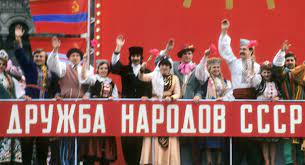 Dmitri Trenin
Dmitri Trenin
December 2021 marked the thirtieth anniversary of the breakup of the Soviet Union. December 2022 will mark the centenary of its establishment. In reality, the dissolution of the Soviet Union was a process—one that is still ongoing—rather than a single event. In the meantime, new realities keep changing the geopolitical landscape in Eurasia. In most cases, the term “post-Soviet space” has lost its meaning, so far apart have its former constituent parts diverged. The only case where it still makes sense to refer to the post-Soviet space is in a discussion of Russia’s foreign policy, for which all former borderlands will forever remain its “near abroad.”
Russia’s approach to its geographical periphery, however, has recently undergone major changes. Almost simultaneous developments in several places—Ukraine and Belarus in Eastern Europe, the South Caucasus, and Central Asia—illustrate the nature and direction of these changes. The suspicion that Moscow is busy restoring the Soviet Union under a different name is baseless; in fact, Russia is busy establishing itself as the principal and most consequential power along its new borders. The days of the empire will not return, but Russia the great power is hard at work promoting and protecting its interests.
Deterrence: Ukraine
The crisis that broke out in early 2022 as a result of Russia’s military buildup on the Ukrainian border is billed in the Western media as one between Russia and Ukraine. This is not, however, how it is seen from Moscow. By demonstrating its military capabilities and political resolve to intervene, Russia is seeking to replace the current European security order based on U.S. dominance and NATO’s central role with a new two-pillar architecture based on an agreement between Russia and the United States.
Ukraine is on the frontline of that crisis. By massing troops on the Ukrainian border, Russia wants to deter the United States from admitting Ukraine into NATO or deploying strike weapons such as missiles on the territory of Ukraine. Security is Russia’s top concern, but not the only one. Kyiv’s Western orientation carries the prospect of that part of the core of the historical Russian state being forever estranged from Russia. Not everyone in Moscow is reconciled to that, and Ukraine will remain on the Kremlin’s agenda for a long time to come.
The Ukraine crisis has demonstrated, for the first time since the end of the Cold War, Russia’s readiness to use military force to prevent further expansion of the Western alliance into former Soviet territory. This is a risky strategy, but one that could work, at least partially: in the face of Moscow’s strong opposition, Washington has neither the interest in nor the intention of fighting Russia over Ukraine or provoking Russia too much by deploying U.S. missiles there.
Integration: Belarus
August 2020 was a turning point in Belarusian foreign policy. Alexander Lukashenko’s crackdown on protesters who accused him of rigging the presidential election led to Western countries’ refusal to recognize him as Belarus’s president. With relations with Europe and the United States now in the deep freeze, Lukashenko has had to abandon his multi-vector foreign policy and instead lean heavily on the support and assistance of Russia.
Moscow, in turn, has used the situation to tie Belarus closer to it in economic and military terms under the formula of the Union State which, despite its announcement in 1999, has been far more virtual than real. The Kremlin has also been seeking a political transition in Minsk toward a more predictable and pliant leadership to succeed the wily and unreliable Lukashenko.
This will not be easy. Even if Lukashenko steps down from the presidency, he has no intention of giving up real power in Belarus. Moreover, he has been using the crisis in Russian-Western relations to highlight the importance of Belarus—and himself—to Russia. Yet the same situation is leading to much closer military integration between the two countries and their diplomatic coordination. In a newly divided Europe, Belarus is fully on Russia’s side.
Armenia and Nagorno-Karabakh
The fall of 2020 saw the eruption of a conflict in Nagorno-Karabakh that had been frozen for twenty-six years thanks to a Moscow-brokered ceasefire. Having failed to prevent a new war, Russia found itself in an awkward position between its formal ally Armenia and its valued partner Azerbaijan. Moscow managed to stay out of the fray—its treaty relationship with Yerevan did not cover Nagorno-Karabakh—but had to watch its ally being defeated and its prestige sinking. Equally bad was the fact that Baku’s victory was made possible by Azerbaijan’s close alliance with Turkey, Russia’s historical rival in the region.
Yet Moscow managed to limit the damage to its international standing. It succeeded in stopping the fighting after the Azeri victory had become clear, but before Armenians were completely driven out of the enclave. Moscow brokered a new agreement with the parties to the conflict, which is still holding fifteen months after the end of hostilities; it retained its position as the sole mediator and, for the first time, sent a peacekeeping force to Karabakh. Moscow has also significantly increased its leverage with the Armenian government, whose multi-vector foreign policy, too, has had to develop a Russian accent. Russian troops are now essentially protecting what remains of the Armenian enclave inside the territory of Azerbaijan. Finally, Russia managed to avoid a clash with Turkey by interacting with it in a joint monitoring center in Azerbaijan and even hosting Armenian-Turkish talks in Moscow.
The Nagorno-Karabakh crisis revealed that Russia will put its national interest above emotions—whether in regard to its ally Armenia or its old-new rival-cum-partner Turkey—as well as its ability to maintain balance in the most intricate situations, and its readiness to use military force for peacekeeping purposes.
Stabilizing Kazakhstan
In early January 2022, widespread social protests soon turned into violent and deadly riots in Kazakhstan, a country with which Russia shares a 7,500 kilometer mostly unprotected border. The protests, rooted in popular anger over inequality, and the riots, which had much to do with intra-elite rivalry, threatened to plunge the country into chaos. Taken off guard, Russia responded virtually instantaneously to a call for help from Kazakhstan’s president. To help Kazakhstan to restore order, Russia activated the Collective Security Treaty Organization (CSTO), a previously soft security arrangement among six ex-Soviet states. For the first time since its founding in 1999, the Russia-led CSTO mounted a peacekeeping operation that resulted in the dispatch of 2,500 troops, mostly airborne, that allowed Kazakhstani forces to move against the rioters to restore order.
Russia surprised the world by how swiftly it sent troops to Kazakhstan, how effective that support was and how the risk of clashing with local rioters was avoided, and then how quickly—just two weeks after the start of the operation—the CSTO force withdrew completely. As a result, Russia not only eliminated the threat of Kazakhstan’s disintegration, but also strengthened its influence there.
These new elements in Russia’s policies toward the former Soviet states suggest that Russia is strengthening its geopolitical position in northern Eurasia. It has used military force to deter the United States and NATO in Ukraine; employed economic, financial, and political means to promote integration in Belarus; engaged in diplomacy and peacekeeping in the South Caucasus; and organized a multilateral stabilization mission in Kazakhstan. So far, Moscow has succeeded in protecting and promoting its security and geopolitical interests with comparatively limited means, but the task of rebuilding Russia as the leading great power—not an empire—in the space previously occupied by the Soviet Union will take a sustained effort over a fairly long period of time. One thing is clear: the geopolitical retreat that Russia began three decades ago has ended, and a new policy of selective expansion based on Russia’s national interests has commenced.
This article was originally published in Japanese by Kyodo News
- Dmitri Trenin
Carnegie does not take institutional positions on public policy issues; the views represented herein are those of the author(s) and do not necessarily reflect the views of Carnegie, its staff, or its trustees.




